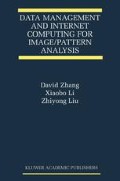Abstract
In this chapter, a novel filtering algorithm is presented to restore images corrupted by impulsive noise. As a pre-processing procedure of the noise cancellation filter, an improved impulse detector is used to generate a binary flag image which gives each pixel a flag indicating whether it is an impulse. This flag image has two uses: 1) A pixel is modified only when it is considered as an impulse; otherwise, it is left unchanged. 2) Only the values of the good pixels are employed as useful information by the noise cancellation filter. Section 7.2 describes the impulse noise model assumed by our experiments and presents an iterative impulse detection algorithm which provides us with more accurate detecting results than those of previously proposed methods. To remove noises from the corrupted image, in Section 7.3, we propose a new filter called polynomial approximation (PA) filter which is developed by modeling a local region with a polynomial that can best approximate the region under the condition of least square error. Section 7.4 introduces an adaptive approach that can automatically determine the orders of the polynomials. The proposed two kinds of PA filters, fixed-order and adaptive-order PA filters, are tested on images corrupted by both fixed-valued and random-valued impulsive noise. Some further simulation and comparison results are given in Section 7.5. Finally, a brief conclusion is drawn in Section 7.6.
Access this chapter
Tax calculation will be finalised at checkout
Purchases are for personal use only
Preview
Unable to display preview. Download preview PDF.
References
S.T. Bow, Pattern Recognition and Image Processing, Marcel Dekker, Inc., New York, 1992.
H. Lin, A.N. Willson, “Median filter with adaptive length,”IEEE Trans. Circuits and Systems35(6):675–690, 1988.
T. Sun and Y. Neuvo, “Detail-preserving median based filters in image processing,”Pattern Recognition Letters,15:341–347, 1994.
R.C. Hardie and C.G. Boncelet, “LUM filters: A class of rank-orderbased filters for smoothing and sharpening”IEEE Trans. Signal Processing41(3):1061–1076, 1993.
R.C. Hardie and K.E. Barney, “Rank conditioned rank selection filters for signal restoration,”IEEE Trans. Image Processing3(2):192–206, 1994.
T. Sun M. Gabbouj and Y. Neuvo, “Center weighted median filters: Some properties and their applications in image processing,”Signal Processing35:213–229, 1994.
G. Ramponi, “The rational filter for image smoothing,”IEEE Signal Processing Letters3(3):63–65, 1996.
F. Russo and G. Ramponi, “A fuzzy filter for images corrupted by impulse noise,”IEEE Signal Processing Letters3(6):168–170, 1996.
L. García-Cabrera, M.J. García-Salinas, P.L. Luque-Escamilla, J. Martínez-Aroza, J.F. Gómez-Lopera and R. Román-Roldán, “Median-type filters with model-based preselection masks,”Image and Vision computing14:741–752, 1996.
E. Abreu, M. Lightstone, S.K. Mitra and K. Arakawa, “A new efficient approach for the removal of impulse noise from highly corrupted images,”IEEE Trans. Image Processing5(6):1012–1025, 1996.
D. Zhang and Z. Wang, “Impulse noise detection and removal using fuzzy techniques,”Electronics Letters33:378–379, 1997.
Z. Wang and D. Zhang, “Restoration of impulse noise corrupted images using long-range correlation,”IEEE Signal Processing Letters5(1):5–8, 1997.
Author information
Authors and Affiliations
Rights and permissions
Copyright information
© 2001 Springer Science+Business Media New York
About this chapter
Cite this chapter
Zhang, D., Li, X., Liu, Z. (2001). Impulse Noise Removal Algorithms for IAP. In: Data Management and Internet Computing for Image/Pattern Analysis. The International Series on Asian Studies in Computer and Information Science, vol 11. Springer, Boston, MA. https://doi.org/10.1007/978-1-4615-1527-2_7
Download citation
DOI: https://doi.org/10.1007/978-1-4615-1527-2_7
Publisher Name: Springer, Boston, MA
Print ISBN: 978-1-4613-5598-4
Online ISBN: 978-1-4615-1527-2
eBook Packages: Springer Book Archive

